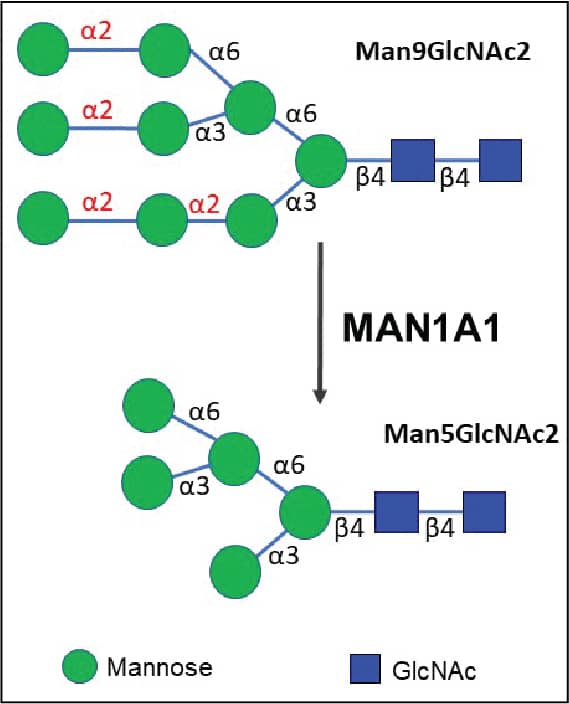Recombinant Human VSIG4 Fc Chimera Avi-tag Protein, CF
Recombinant Human VSIG4 Fc Chimera Avi-tag Protein, CF Summary
Learn more about Avi-tag Biotinylated ProteinsProduct Specifications
| Human VSIG4 (Arg20-Pro283) Accession # Q9Y279.1 | IEGRMD | Human IgG1 (Pro100-Lys330) | Avi-tag |
Analysis
Customers also Viewed
Product Datasheets
Carrier Free
CF stands for Carrier Free (CF). We typically add Bovine Serum Albumin (BSA) as a carrier protein to our recombinant proteins. Adding a carrier protein enhances protein stability, increases shelf-life, and allows the recombinant protein to be stored at a more dilute concentration. The carrier free version does not contain BSA.
In general, we advise purchasing the recombinant protein with BSA for use in cell or tissue culture, or as an ELISA standard. In contrast, the carrier free protein is recommended for applications, in which the presence of BSA could interfere.
AVI4646
| Formulation | Lyophilized from a 0.2 μm filtered solution in PBS with Trehalose. |
| Reconstitution | Reconstitute at 200 μg/mL in PBS. |
| Shipping | The product is shipped at ambient temperature. Upon receipt, store it immediately at the temperature recommended below. |
| Stability & Storage: | Use a manual defrost freezer and avoid repeated freeze-thaw cycles.
|
Scientific Data
 View Larger
View Larger
When Human iC3b is immobilized at 2.5 μg/mL (100 μL/well), the concentration of Biotinylated Recombinant Human VSIG4 Fc Chimera Avi-tag (AVI4646) that produces 50% optimal binding response is found to be approximately 5-40 ng/mL.
 View Larger
View Larger
2 μg/lane of Biotinylated Recombinant Human VSIG4 Fc Chimera Avi-tag (Catalog # AVI4646) was resolved with SDS-PAGE under reducing (R) and non-reducing (NR) conditions and visualized by Coomassie® Blue staining, showing bands at 65-85 kDa and 130-170 kDa.
Background: VSIG4
V-set and immunoglobulin domain containing 4 (VSIG4), also known as CRIg and Z39IG, is a type I transmembrane protein of the B7 family and complement receptor of the immunoglobulin superfamily. Human VSIG4 consists of an extracellular domain (ECD) containing a V-type and a C2-type Ig domain, a transmembrane domain and a cytoplasmic domain (3). Interestingly, VISG4 in several animals, including mouse and rat, lack the C2-type Ig domain present in human VSIG4. Within the IgV domain, mature human VSIG4 shares 80% and 78% amino acid identity with mouse and rat VSIG4, respectively. Alternative splicing results in numerous isoforms lacking all or part of the cytoplasmic domain, the C2-type Ig domain and/or the transmembrane domain. VSIG4 is specifically expressed on macrophages in the thymic medulla, peritoneum, alveoli, synovia, adipose and heart, liver Kupffer cells, placental Hofbauer cells, and atherosclerotic foam cells (1-8). It is absent on infiltrating macrophages (8). VSIG4 is a complement receptor that binds C3b and iC3b fragments, internalizes them to recycling endosomes, and is recycled to the cell surface (4, 5). It contributes significantly to innate immunity by binding and phagocytosis of complement-opsonized invading pathogens (4, 7, 9). Binding of either native or recombinant soluble VSIG4 to C3b inhibits complement amplification through the alternative, but not classical, pathway (9, 10). VSIG4 is also a negative regulator of mouse and human T cell activation (2). Although VSIG4 engagement may activate NF kappa B and thus be pro-inflammatory in some cases, many of its activities are important in resolving, rather than initiating, inflammation (1, 2, 6, 9, 10). VSIG4 expression has been implicated in lung cancer development and associated with poor prognosis of high grade glioma (11, 12). Our Avi-tag Biotinylated Recombinant VSIG4 features biotinylation at a single site contained within the Avi-tag, a unique 15 amino acid peptide. Protein orientation will be uniform when bound to streptavidin-coated surface due to the precise control of biotinylation and the rest of the protein is unchanged so there is no interference in the protein's bioactivity.
- 1. He, J.Q. et al. (2008) Mol. Immunol. 4041.
- Vogt, L. et al. (2006) J. Clin. Invest. 116:2817.
- Langnaese, K. et al. (2000) Biochim. Biophys. Acta 1492:522.
- Helmy, K. et al. (2006) Cell 124:915.
- Tanaka, M. et al. (2008) Clin. Exp. Immunol. 154:38.
- Lee, M-Y. et al. (2006) J. Leukoc. Biol. 80:922.
- Gorgani, N.N. et al. (2008) J. Immunol. 181:7902.
- Walker, M.G. (2002) Biochim. Biophys. Acta 1574:387.
- Wiesmann, C. et al. (2006) Nature 444:217.
- Katschke, K.J. et al. (2007) J. Exp. Med. 204:1319.
FAQs
No product specific FAQs exist for this product, however you may
View all Proteins and Enzyme FAQsReviews for Recombinant Human VSIG4 Fc Chimera Avi-tag Protein, CF
There are currently no reviews for this product. Be the first to review Recombinant Human VSIG4 Fc Chimera Avi-tag Protein, CF and earn rewards!
Have you used Recombinant Human VSIG4 Fc Chimera Avi-tag Protein, CF?
Submit a review and receive an Amazon gift card.
$25/€18/£15/$25CAN/¥75 Yuan/¥2500 Yen for a review with an image
$10/€7/£6/$10 CAD/¥70 Yuan/¥1110 Yen for a review without an image








